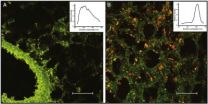(Press-News.org) BUFFALO, N.Y. -- Researchers at the University at Buffalo have developed a novel technology using quantum dots that is expected to have major implications for research and treatment of tuberculosis, as well as other inflammatory lung diseases.
A paper appearing online in Nanomedicine: Nanotechnology, Biology and Medicine as an article-in-press describes specific delivery of a chemotherapeutic drug to specific cells in the lung, particularly the alveolar white cell, without causing acute inflammation.
Quantum dots are tiny semiconductor particles generally no larger than 10 nanometers that can be made to fluoresce in different colors depending on their size. Scientists are interested in quantum dots because they are a superb carrier and last much longer than conventional dyes used to tag molecules, which usually stop emitting light in seconds.
"The ability to target specific cells in the lung without exposing surrounding cells and tissue or distant organs to the detrimental effects of drugs is an exciting avenue to explore," says Krishnan V. Chakravarthy, PhD, a research fellow in the UB School of Medicine and Biomedical Sciences joint MD/PhD program and lead author on the paper.
"We have been able to prove this in both cultured cells and in animals," he continues. "The technology is still in its infancy, but being able to conduct these experiments in the whole animal makes it more promising as a clinical application. The long-term goal would be to do targeted drug delivery through aerosolized techniques, making it suitable for clinical use."
Researchers in UB's Institute of Lasers, Photonics and Biophotonics have made major advancements in the use of quantum dots, sometimes called artificial atoms, to build new devices for biological and environmental sensing.
In this research, quantum dots were linked with doxorubicin, an anti-cancer chemotherapy drug, to target specific lung cells, known as alveolar macrophages (aMØ) which play a critical role in the pathogenesis of various inflammatory lung injuries.
"The aMØ is the sentinel cell involved in directing the host innate and adaptive immune responses involved in infectious and non-infectious lung diseases such as COPD," notes Chakravarthy. "The aMØ's central role in response to environmental influences makes these cells an ideal candidate for targeted drug delivery to modulate the immune/inflammatory response."
To test the ability of linked quantum dot-doxorubicin (QD-DOX) to decrease lung inflammation, the researchers delivered QD-DOX or doxorubicin alone to rats and mice and assessed the damage to the lung. Doxorubicin, a frequently used cancer drug, is known to cause a variety of damaging immune responses in cancer patients.
Results showed that QD-DOX increased uptake of the drug compared with doxorubicin alone, and did not cause as significant a pro-inflammatory response as doxorubicin alone. The researchers also demonstrated that the drug is released from the QD-DOX formulation once it is delivered into the targeted cell and still retains its bioactivity.
"Based on these results, we believe that linking quantum dots with therapeutic drugs may have tremendous potential for diagnosis and treatment of lung injury compared to other nanoparticle formulations, and should be further developed for lung pharmacotherapy applications," says Chakravarthy.
INFORMATION:
Additional authors on the paper, all from UB, are Bruce A. Davidson, PhD; Jadwiga D. Helsinki; Hong Ding, PhD; Wing-Cheung Law; Ken-Tye Yong, PhD; Paras N. Prasad, PhD; and Paul Knight, MD, PhD.
The research is supported by grants from the National Institutes of Health to Chakravarthy, Knight and Prasad, and by a grant from John Oishei Foundation to Prasad.
The University at Buffalo is a premier research-intensive public university, a flagship institution in the State University of New York system and its largest and most comprehensive campus. UB's more than 28,000 students pursue their academic interests through more than 300 undergraduate, graduate and professional degree programs. Founded in 1846, the University at Buffalo is a member of the Association of American Universities.
Cancer drug linked to quantum dots increases drug uptake, reduces inflammation
2010-11-02
ELSE PRESS RELEASES FROM THIS DATE:
Elderly women at higher risk for unnecessary urinary catheterization, study reports
2010-11-02
Washington, November 1, 2010 – Elderly women are at high risk for inappropriate urinary catheter utilization in emergency departments, according to a new study in the November issue of the American Journal of Infection Control, the official publication of the Association for Professionals in Infection Control and Epidemiology (APIC).
The study was conducted at St John Hospital and Medical Center, a 769-bed tertiary care teaching hospital in Detroit, Mich. The authors examined 532 instances in which urinary catheters were placed in emergency room patients over a 12-week ...
Some city trees may discourage 'shady' behavior
2010-11-02
Along with energy conservation and storm-water reduction, scientists may soon be adding crime-fighting to the list of benefits that urban trees provide. Researchers with the U.S. Forest Service's Pacific Northwest (PNW) and Southern Research Stations have published a new study that suggests that certain types of city trees may help lower property and violent crime rates. Their study—which is posted online in advance of its appearance in a forthcoming printed issue of the journal Environment and Behavior—is the first to examine the effects of trees and other factors on crime ...
'Training away stereotypes'
2010-11-02
COLUMBIA, Mo. – It may seem difficult to change stereotypical thinking. Perceptions can be very important in forming an individual's attitudes. Now, researchers at the University of Missouri have found that people conditioned to think in opposition to racial stereotypes are more receptive to people from minority groups starring in commercial advertising.
Saleem Alhabash, a doctoral candidate in the University of Missouri School of Journalism.
"This research shows that when people are trained to think in a non-stereotypical way, they will pay more attention to ads with ...
If GMO genes escape, how will the hybrids do?
2010-11-02
GMOs, or Genetically Modified Organisms, may raise concerns of genes escaping from crops and having unknown effects on natural, wild species. But what is the real risk that traits associated with GMOs will actually migrate to and persist in their wild relatives? Interest in plant ecology, crop production and weed management led John Lindquist and his colleagues from the University of Nebraska and USDA-ARS to investigate how gene flow from a cultivated crop to a weedy relative would influence the ecological fitness of a cropwild hybrid offspring. They published their findings ...
After good or bad events, people forget how they thought they'd feel
2010-11-02
WASHINGTON —People aren't very accurate at predicting how good or bad they'll feel after an event -- such as watching their team lose the big game or getting a flat-screen TV. But afterwards, they "misremember" what they predicted, revising their prognostications after the fact to match how they actually feel, according to new research.
These findings appear in the November issue of the Journal of Experimental Psychology: General, published by the American Psychological Association.
Although the process of predicting emotions seems imprecise from start to finish, misremembering ...
Zebrafish yield clues to how we process visual information
2010-11-02
To a hungry fish on the prowl, the split-second neural processing required to see, track, and gobble up a darting flash of prey is a matter of survival.
To scientists, it's a window into how our brain coordinates the eye motions that enable us to hit a baseball, sidestep an errant skateboarder, and otherwise make our way in a world full of danger and opportunity.
This process is now better understood, thanks to a team of scientists that imaged the activity of individual neurons in a part of a zebrafish's brain called the optic tectum. The optic tectum receives signals ...
Management science guru, surviving cancer, offers hope to fellow sufferers, doctors
2010-11-02
When Stephen Barrager was diagnosed in 2007 with acute multiple myeloma, a form of bone marrow cancer, he endured the same anxiety that troubles all those who receive an upsetting diagnosis. The way he went about dealing with his disease and its treatment, however, was different. Barrager drew upon his engineering and management science background to help him make difficult decisions. Now he is sharing his insights with hospitals and doctors in his native Bay Area and with colleagues at a conference coming to Austin on Nov. 7, 2010.
The annual meeting of the Institute ...
UCI non-small cell lung cancer study highlights advances in targeted drug therapy
2010-11-02
Orange, Calif., Nov 1, 2010 — A UC Irvine oncologist's work with a targeted therapy is showing great promise in patients with a deadly form of lung cancer. The results were published Thursday in the New England Journal of Medicine.
The multicenter study is testing whether the drug crizotinib effectively slows, stops or reverses growth in advanced non-small cell lung cancer tumors by targeting a genetic mutation that causes uncontrolled tumor growth. Study participants all tested positive for a mutation in the anaplastic lymphoma kinase gene.
According to the findings, ...
Collecting your thoughts: You can do it in your sleep!
2010-11-02
It is one thing to learn a new piece of information, such as a new phone number or a new word, but quite another to get your brain to file it away so it is available when you need it.
A new study published in the Journal of Neuroscience by researchers at the University of York and Harvard Medical School suggests that sleep may help to do both.
The scientists found that sleep helps people to remember a newly learned word and incorporate new vocabulary into their "mental lexicon".
During the study, which was funded by the Economic and Social Research Council, researchers ...
MRI may help determine time of stroke onset
2010-11-02
OAK BROOK, Ill. – Magnetic resonance imaging (MRI) of the brain could expand the number of stroke patients eligible for a potentially life-saving treatment, according to a new study, published online and in the December issue of the journal Radiology.
Some patients who suffer an acute ischemic stroke — in which a blood clot or other obstruction blocks blood flow in the brain — can be treated with a drug called tissue plasminogen activator, or tPA, that dissolves the clot and restores blood flow. However, the clot-busting drug can only be administered within four and a ...

